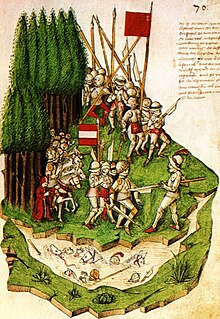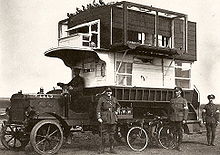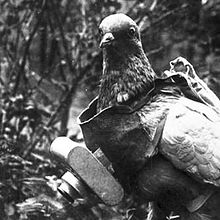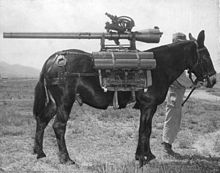Animals in the military

Animals in the military refers to the use of animals for warfare. Animals of various kinds have played a role in logistics, combat, reconnaissance , espionage and defense for at least 2000 years . The armed forces of different nations use or still use various animal species in military conflicts.
history
The Roman poet Lucretius reported in the 1st century BC By boars that attacked war elephants in much earlier times. The US Navy has been using marine animals in its Marine Mammal program since the Vietnam War - such as sea lions and dolphins to track down sea mines .
There were always individual cases where animals earned special services in the military. A typical example is a Syrian brown bear, which served the Polish troops as an ammunition carrier in the fight against the German Wehrmacht in southern Italy. Wojtek even had military rank and "owned" a pay book.
Even in World War II, horses brought military equipment and supplies to the front, dogs intimidated opponents and, like carrier pigeons , brought messages. These are the three most important animal species for war, established over centuries.
Riding and pack animals
The cavalry was in addition to the infantry since ancient times one of the strongest military service branches. Bucephalus , the warhorse of Alexander the great , was considered the most famous horse of antiquity. Horses embodied mobility, speed and punch. They changed military strategies and tactics, much like tanks and military planes later did. In order to protect the animals important for the war, armor for horses was invented. Specially trained infantrymen targeted horses with spears. Until the spread of handguns, the riders mostly fought next to the sword with a bow and arrow. There were warhorses and army horse . The crusades were wars with a massive use of organized equestrian units - the cavalry.
Cattle were used as transport animals , but were of secondary importance in war operations because of their poor maneuverability. In mountainous regions that are difficult to access, mules were militarily important in both world wars. In contrast, war elephants played a major role in the Indian and North African regions.
Camels were used in the deserts of North Africa and the Arabian Peninsula . There were mobile veterinary clinics for horses; gas masks were developed for the animals against the use of poisonous gas.
In the run-up to the First World War, the need for horses as part of the armament increased so much that there was a brisk trade in thousands of animals across Europe. Horses were part of the armament. The magazine Die Woche wrote in the June 1913 issue:
- In order to be able to reinforce our mounted troops, in accordance with today's conditions, the number of horses in the German army must also be increased. If this is to be successful, a total of 27,000 horses would have to be procured, but the army administration initially only wants to hire 17,000 horses, of which 8,000 are to be used as riding horses and 9,000 as draft horses. Fortunately, with the further increase in state horse breeding, many things have changed, although it must be admitted that with the enormous horse consumption in the event of a war, the "replenishment" is likely to be difficult, which is why authorities in this field established a war reserve years ago of military horses proposed.
In 1917 Great Britain had over a million horses in action. On some days 1,000 horses came to France across the canal to replace injured or killed animals. At the start of World War II in 1939, only Poland had significant mounted troops in Europe .
dogs
Large dogs played a role in the armies of ancient times and the early Middle Ages. You should frighten the opponent. In the High Middle Ages, dogs were used as "reporters", i.e. for running errands. During Henry V's second Italian expedition in 1118, a dog is said to have brought letters from the besieged troops to their papal allies. In 1885 the Prussian military began training dogs for patrols. In the First World War, police dogs were used and dog breeders' associations were approached - usually successfully. Anti-tank dogs were also used . In the neighboring countries there were hardly any dogs in action. The Belgians used dogs as draft animals for smaller loads.
See also Use of dogs in the military
Because of the dogs' emotional bond with their trainer, the latter usually had to go into battle with them. The animals often lost their bearings because of the unusual noise of the battle. Dogs became more and more important, especially in trench warfare, because they could relieve human reporters of the work. In some cases, dogs have been allowed to lay telephone lines. The First World War wore out over a million horses and several thousand dogs. Reporting dogs were also used to transport war pigeons to a location from which they would fly back.
Pigeons
Certain pigeon species , like many migratory birds, have a precise sense of direction. Once hundreds of kilometers from the starting point, most of them find their way back home. This property was already used by warlords in ancient times. So communicated in 44 BC The Caesar murderer Brutus in the Mutinensian War from the siege by means of carrier pigeons with the outside world. When Paris was besieged in the Franco-Prussian War in 1871 , the trapped troops sent off 500 pigeons using balloons ; 100 came back with messages written in small rolls on light paper.
In the First World War, the German military alone deployed over 20,000 "war pigeons", France and Great Britain significantly more. The non-military use of the birds was a criminal offense. The pigeons were almost synonymous with espionage. Telegraph lines played an increasingly important role in the war, but the lines often tore, were sensitive to moisture, etc. In the battle for Verdun , one of the longest and bloodiest positional battles , seven mobile dovecotes were active. If a combatant captured enemy positions, he burned the pigeon houses. Gas protection containers were made for the war pigeons. The actual reporting sleeves were made of the light metal aluminum and were attached to the legs or chest. The texts contained therein were often encrypted and were called "Taubensprüche".
Some pigeons, such as Cher Ami and GI Joe , received military honors for their special achievements in the First World War.
Due to the increasing radio traffic and modern communication technologies, the pigeons largely disappeared from the battlefields of World War II. In individual cases, such as the Battle of Monte Cassino in 1944, pigeons still played a role as conveyors of news in the scenario of a disturbed radio operation. The Swiss Army abolished its "self-reproducing small missiles" in 1995.
Military use of animals in the present
Marine mammals
For the detection of mines, the placement of explosive devices on submarines and for the detection and defense of combat swimmers, trained dolphins and sea lions were and are used - for example in the US Navy, but also the Russian Navy used biological combat systems. This type of use of animals is ethically highly controversial.
Horses and mules
Today the cavalry is being replaced by motorized troops, but some armies still have horses and mules in their stocks, for example in the form of trains to transport material in rough terrain or to guard the border.
Service dogs
Even today, especially among the infantry, special forces, pioneers and field hunters, service dogs are increasingly used as protection dogs, to search for people as well as explosives, ammunition and mines, but also as drug and money detection dogs - primarily in the police force. Fighting dogs also rarely used as danger defense dogs.
Animal names and weapons of war
Since certain abilities and strengths of character of animals were and are always a role model and a great help in military research, logistics, security and combat, many weapon systems manufactured in modern times bear animal names. Examples are the French helicopter Alouette II (dt .: lark ), the British fighter pilot Hawk ( bird of prey ), the tanks Tiger , Puma , Leopard or the VW Iltis , but the drone ( UAV ) is used. Also acronyms in use that are associated with animals in connection. Here can US Navy SEALs ( seals ) are called.
literature
- Thomas Jander: Animals in War Service: Carrier Pigeons and Registration Dogs 1914–1918 . The archive, magazine for communication history of the Museum for Communication Berlin , issue 1/2015. Pp. 14-23, ISSN 1611-0838
- Stefan Kaufmann: Communication technology and warfare 1815-1945 , Wilhelm Fink Verlag, Paderborn 2000, ISBN 3-7705-3153-1
- John. M. Kistler: Animals in the Military: From Hannibal's Elephants to the Dolphins of the US Navy , ABC-Clio 2011, ISBN 978-1-59884-346-0
- Martin Monestier: Les animaux-soldats. Histoire militaire des animaux des origines à nos jours , Le Cherche Midi 1996, ISBN 2-86274-438-7
- Martin Schletterer: The dove in the course of time , The other publishing house, Uelvesbüll 2004, ISBN 3-89959-175-5 .
Web links
- Bayerischer Rundfunk: animals as weapons - of feathered heroes and deadly four-legged friends - radioWissen. (MP3 podcast) In: Radio knowledge. October 31, 2019, accessed January 15, 2020 .
See also
- War animals in the First World War
- Apopo - project to clear mines with sniffer rats
- Bat bomb
- War elephant
- Animals in War Memorial
Individual evidence
- ↑ Federal Archives Image 183-R01996
- ↑ Lucretius: De rerum natura . Lucretius describes the animals essentially as unsuitable for combat use. Quote: “They also tried to use bulls in the service of war / and to send wild boars towards the enemy. / Yes, fierce lions were sent ahead of the army / Which were led by armed guards and cruel tamers / In order to be able to guide them and to keep them firmly by the chain. / But in vain! Heated by the bloodbath on both sides / They furiously confused the ranks of friend and foe, / Here and there the manes of the head shaking the terrible ones. / Before the roar, the horses shied away from the roar, the riders could / Never hold the animals or steer them against the enemy. "(Translated from Latin by Hermann Diels , 1924)
- ↑ Eva Sudholt: War pigeons that became heroes , Die Welt from April 27, 2014, p. 6
- ↑ Swiss Army decommissioning their carrier pigeons , Die Welt from July 6, 1996 , accessed on May 17, 2015
- ↑ https://www.t-online.de/tv/webclips/id_84234336/us-marine-setzt-delfine-zur-minenjagd-ein.html Here dolphins go mine hunt, accessed on August 6, 2018
- ↑ Animals and the military , Military History Museum of the Bundeswehr ( Memento of the original from May 9, 2016 in the Internet Archive ) Info: The archive link has been inserted automatically and has not yet been checked. Please check the original and archive link according to the instructions and then remove this notice. , accessed May 17, 2015



